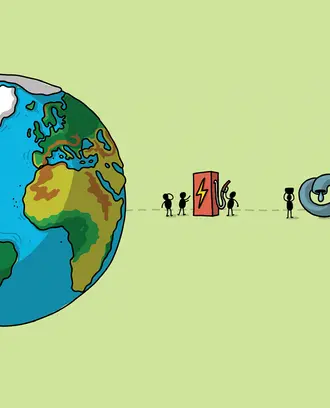Credit: Stephen Sauer
It won’t be easy. Despite good feelings and good press about clean energy projects, there is still a substantial gap, the “valley of death,” between idea and commercialization. At Generate Capital, Yancan “Lydia” Li is working to close that gap by using low cost-of-capital funding to grow clean energy and sustainable infrastructure projects.
Li, MBA ’19, also lobbied for and received the resources to develop an internship program at her company, creating pathways for people from underrepresented groups to build careers in sustainable investing.
It’s this persistence that landed Li on the Forbes 30 Under 30 list for energy earlier this year. Forbes cited Li’s more than $200 million in investments in the power, transport, and waste sectors.
“Her technical research and financial analyses allowed Generate to underwrite first-of-its-kind hydrogen infrastructure and fuel cell projects that could not raise capital from traditional investors,” according to Forbes.
We spoke with Li about how idea generation works at Generate Capital, what it took to launch the internship program, and the podcasts and newsletters she uses to stay on the leading edge of energy investing.
What inspires you?
I have worked in finance and investing my whole career, while I am also very passionate about creating positive impact on society. So what inspires me is making investments that can create both attractive financial returns as well as social or environmental impact. When talking about “impact investing,” many people think that it means sacrificing returns in order to pursue other benefits. However, I chose my current career path hoping that I could prove sustainability creates value for investors as well.
Who inspires you?
Jigar Shah, the person who co-founded my current company, Generate Capital, has always been an inspiration to me. Jigar founded SunEdison, where he pioneered “no-money-down solar” and unlocked a multibillion-dollar solar market, creating the largest solar services company worldwide. I had been listening to Jigar’s podcast, The Energy Gang, for many years, before I eventually got a chance to join his company. As an entrepreneur turned investor, Jigar is not only extremely knowledgeable about the clean energy sector, but he’s also so generous and always happy to share his insights with everyone. I’m particularly inspired by how much he’s willing to connect with those who are far from being potentially helpful for him. Jigar is just there to offer help.
During COVID I heard from current students at MIT and other friends that people have been struggling to find career opportunities in the clean energy and sustainability space. Inspired by Jigar, I started offering 30-minute career chats with anyone who would want to speak with me. I did over 120 calls in a year and found it very inspiring to learn from these students and young professionals as well.
Where do you get ideas?
I have a couple podcasts and newsletters that I follow to keep myself informed (and entertained).
Podcasts: The Energy Gang, Interchange, NPR’s How I Built This and Planet Money, and The Economist’s The Intelligence.
Newsletters: Bloomberg Green, Climate Tech VC, Matt Levine’s Money Stuff, The New Yorker’s John Cassidy on politics and the economy, and Amy Davidson Sorkin on world news and American politics.
How are new ideas discovered and developed in your organization?
Generate Capital builds, finances, owns, and operates sustainable infrastructure projects. We have a formal strategy generation process, where investment team members conduct thorough research and pitch new investment theses in sectors or asset classes that Generate has not built out previously. We also generate ideas with our development partners on an ongoing basis in order to help provide innovative solutions to meet their need for capital and/or operational support.
How do you keep track of new ideas?
I use both digital and traditional tools to keep track of my ideas. The process of writing down lists or drawing a chart really helps me think through complicated problems. Prior to COVID, I took notes and created lists/trackers mainly on yellow legal pads or whiteboards. Since we started working from home, I’ve switched to more digital tools in order to share ideas more easily and collaborate with my team. I enjoy using OneNote, and recently discovered miro, which is an online whiteboarding tool.
Who do you share new ideas with?
My team members: on projects or deals that I currently work on; new investment theses that I want to develop.
Other colleagues: projects or initiatives that would potentially have broader impact and would require buy-ins from people outside of my own team.
Family and friends: ideas that are not related to work or sometimes “wild” ideas that may be silly.
How do you know an idea is a good one?
I don’t always know if an idea is a good one, but there are some things that I just feel very passionate about and want to “be the change I want to see in the world.”
Related Articles
I’m volunteering on the JEDI (justice, equity, diversity and inclusion) council at my current company, and one example of a “good idea” that I’ve been working on is to establish an internship program that attracts HUG (historically underrepresented groups) candidates. Our full-time recruiting process typically requires certain levels of experience and industry knowledge, which may prevent people who have unconventional backgrounds from competing for these roles. In order to expand the funnel for HUG hires at Generate and throughout the renewable energy sector, I came up with the idea of an internship program where we could provide training and mentorship for candidates and expand access to these jobs.
I knew from the beginning that this would be a good idea, but sometimes good ideas can face resistance, too. The internship program required a lot of resources, including extra budget to cover salaries and training costs; it also would need employees to volunteer their time for intern recruiting, curriculum design, and mentorship throughout the summer in order to make this a successful program. We are a relatively small company with a very lean team, so it would be a big lift to pull it off. I got buy-in from various stakeholders, brought together volunteers, and persuaded decision-makers to agree to proceed with this idea. Having done all of that, I realized this process of bringing a good idea through execution was extremely rewarding.
At MIT Sloan, we talk about ideas made to matter — ideas that are carefully developed and have meaningful impact in the world. In that context — what is your idea made to matter?
As I mentioned previously, I have chosen a career in environmental impact investing. I fundamentally believe in the idea that successful investments we make can generate both positive environmental impact and attractive financial returns. As part of a research paper I completed while at MIT, I studied the “valley of death” faced by cleantech companies as they struggle to raise capital to advance from technology development to commercial deployment. Patient, private investors who are able to understand new technologies while bringing low cost-of-capital funding are essential to bridging this gap.
There are a lot of challenges we face in order to achieve this “double bottom line.” Making investments that create good returns is already quite hard. It typically requires comprehensive analyses of risks and returns, deep understanding of the market/sector, careful structuring and execution, and flexibility to pivot if needed. On top of that, we would need to measure the actual environmental impact our investments create as the projects operate.
Despite all the difficulties, I think we have seen some successful examples from investors who are set to prove that investing in sustainability is actually more profitable than the alternative. What is very important to me is that we can provide real metrics for actual kilowatt-hours of clean energy or tons of renewable fuel our assets have generated, instead of stating in hypothetical terms “if this technology works and gets scaled in 10 years, it would be reducing carbon emission by xx.” I hope there will be more capital dedicated to investments that can truly create the environmental impact we need while rewarding investors for that dedication.



